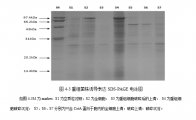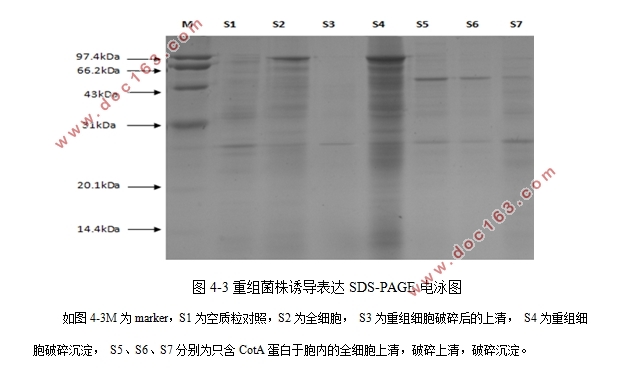细菌漆酶的细胞表面展示及在染料脱色中的应用

细菌漆酶的细胞表面展示及在染料脱色中的应用(论文11000字)
摘要
漆酶(Laccase),重要的含铜离子的氧化还原酶,是理想的工业脱色的原料,非常有应用前景。漆酶以氧气为氧化反应的电子受体,能够将酚型底物和一些毒性有机物彻底降解为二氧化碳。若在漆酶的反应过程中加入能帮助电子传递的小分子物质(在本实验中使用ABTS),可以加快氧化褪色的速率,对于染料褪色效果也会有不同程度的促进作用。反应全程无需过氧化氢参与,且整个反应的副产物只有水,因此开发漆酶处理工业废水技术是目前工业研究重点,也是未来廉价高效、绿色环保的治理方法。漆酶作为一种高效催化剂可以很好的运用于环境修复、食品工业、造纸工业等领域。真菌来源的漆酶与细菌来源的漆酶分泌的“地点”不同,真菌漆酶存在于细胞外部,细菌漆酶是胞内蛋白,存在于细胞内部。这意味着需要更多额外的措施,才能获得和使用细菌漆酶应用于生产与实验中,例如使用超声破坏细胞、融菌剂、离心或使用固定方法等。最近,全细胞催化剂系统的开发特别是利用微生物基因工程进行蛋白质表面展示在未来染料降解的应用中显示了巨大潜力。细菌表面展示允许目标酶表达展示在大肠杆菌和枯草芽孢杆菌等细菌的表面,这样更容易获得较低的成本。 [版权所有:http://DOC163.com]
本实验用的漆酶CotA基因来源于枯草芽孢杆菌 (Bacillus subtilis168),序列信息获得于美国生物技术信息中心,基因序列全长1542 bp,CotA转录蛋白约为66KDa,漆酶的C末端加有His tag,用于蛋白纯化。通过设计上下游引物,以枯草芽孢杆菌全基因组为模板,运用聚合酶链式反应(Polymerase Chain Reaction,PCR)技术获得漆酶CotA与PgsA基因,将PgsA与CotA基因用重叠PCR连接在一起。用BamH1和Nco1位点内切酶进行双酶切质粒pET-28a,将CotA/PgsA与质粒一步克隆连接到一起,获得的异源表达重组质粒。将该重组质粒转化大肠杆菌E.coliBL21菌株中,通过IPTG(异丙基-β-D-硫代半乳糖苷)诱导发酵法进行异源表达,目的是以锚蛋白为媒介将漆酶蛋白固定在E.coli BL21表面。进而研究了其在染料脱色方面的应用,各取全细胞液1ml,分别加入到15ml初始OD为1的甲基橙,刚果红和结晶紫中,加入10ul1mmol ABTS作为中间体,置于37℃和55℃的摇床24h。由实验结果得到:甲基橙脱色率达到50%,刚果红脱色率达到90%,结晶紫脱色率达到80%。可见此酶对工业处理废水有很高的应用前景。
关键词:漆酶;CotA;细胞表面展示;枯草芽孢杆菌;PgsA;
Surface display a bacteria laccaseCotA from Bacillus subtilis168 on E.coli and its application on dye decoloration [资料来源:http://Doc163.com]
Abstract
Laccase, as an important copper-containing oxidoreductase, has specific redox potential, use oxygen as the oxidation of the electronic receptor. The phenol substrate and some toxic organic matter can be completely degraded to carbon dioxide by this reaction. So the development of lignase treatment of industrial wastewater technology is the focus of industrial research, but also the future cheap and efficient, green environmental management methods. At the same time, laccase as an efficient and green catalyst in the environmental remediation, food industry (wine quality), paper industry (biological bleaching) and other areas of growing concern.However, the bacteria laccase has a low oxidation-reduction potential, and it is necessary to add a low-molecular compound as an intermediate (such as ABTS) to play an electron transfer role in the redox reaction, and unlike most extracellular secretion of fungi laccase, the bacteria laccase always exist in cellular internal. That means there need more additional progress to obtain and use the crude bacterial laccase like cell disruption, enzyme concentration by centrifugation or using immobilization method. Since the development of whole-cell catalyst system by using genetically engineering on microbes, the surface-displayed functional proteins show the great potential on the application of dye degradation in the future. The display of heterologous proteins on the surface of target bacteria has been accomplished over the past decade, exhibiting promising prospects in several biotechnological processes. Bacterial surface display has been attached more attention since it allows target enzyme express on the surface of bacteria like E.coli and Bacillus subtiliswhich obtained easy with low cost.
The laccase gene CotAwas origin from Bacillus subtilis 168. The sequence information was obtained from the American Biotechnology Information Center (www.ncbi.nlm.nih.gov). The length of the gene was 1542bp and the CotAtranscription protein about 66KDa.The C-terminus of the laccase is added with His tag for protein purification.. The laccaseCotA gene was obtained by polymerase chain reaction (PCR). In addition, the PgsAgene sequence was cloned from the Bacillus subtilis genome by designing primers, and the CotA gene was ligated with overlapping PCR. The plasmid pET-28a was digested with BamH1 and Nco1 endonucleaseand the recombinant plasmid was ligated with CotA and PgsAin one step. The plasmid was cloned together with the plasmid to obtain the heterologous expression of the recombinant plasmid. The recombinant plasmid was transformed into Escherichia coli BL21 strain and subjected to heterologous expression by IPTG(isopropyl-β-D-thiogalactoside) induction fermentationand finally the laccase was anchored to the surface of E. coli BL21. Thentake 1ml of whole cell liquid, add 15ml of methyl orange, Congo red and crystal violetto the initial OD1, add 75ul 1mmol of ABTS as an intermediate, placed in 37 ℃ and 55 ℃ shaker 24h Methyl orange decolorization rate of 50%, Congo red decolorization rate of 90%, crystal purple decolorization rate of 80%. It can be seen that this enzyme has a high application prospect for industrial wastewater treatment. [来源:http://www.doc163.com]
Keywords:laccase; CotA gene; cell surface display; Bacillus subtilis;PgsA;
[来源:http://Doc163.com]

目录
摘要 I
Abstract II
2.1 漆酶简介 2
2.1.1 漆酶的生物学背景 2
2.1.2细胞表面展示 2
2.1.3漆酶的应用 2
2.2课题来源及研究内容 3
2.2.1课题来源 3
2.2.2本课题研究内容 3
3.1菌株与载体 4
3.2主要实验仪器及试剂 4
3.3 实验引物 4
3.4材料配制 5
3.4.1 LB液体培养基: 5
3.4.2 卡那霉素抗性溶液: 5
3.4.3 IPTG诱导剂: 5
3.4.4 琼脂糖凝胶配制: 5 [资料来源:http://doc163.com]
3.4.5 SDS-PAGE电泳胶配制: 5
3.5实验方法 5
3.5.1聚合酶链式反应(PCR) 5
3.5.2琼脂糖凝胶电泳: 6
3.5.3 SDS-PAGE电泳: 6
3.5.4甘油冻存菌活化 6
3.5.5 Bacillus subtilis168全基因组DNA的提取: 6
3.5.6质粒提取: 6
3.5.7双酶切操作: 6
3.5.8连接操作: 7
3.5.9全细胞的获取 7
3.5.10全细胞漆酶酶液活性验证 7
3.5.11全细胞脱色效率验证 7
4.1CotA基因、PgsA基因的扩增结果 8
4.2 载体pET28a双酶切结果 8
4.3 pET28a双酶切产物、CotA扩增产物和PgsA扩增产物的连接 8
4.4重组菌株BL21 /pET28a-CotA-PgsA诱导表达结果 9
4.5重组漆酶酶液活性验证 9
4.6酶活的检测 9
4.7漆酶脱色试验 10 [来源:http://www.doc163.com]
第五章总结与展望 13
参考文献 14
致谢 16 [版权所有:http://DOC163.com]
